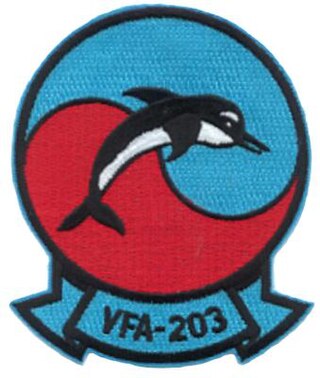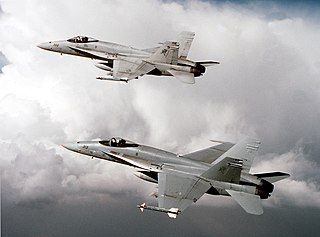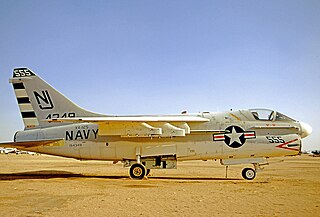A naval flight officer (NFO) is a commissioned officer in the United States Navy or United States Marine Corps who specializes in airborne weapons and sensor systems. NFOs are not pilots (naval aviators), but they may perform many "co-pilot" or "mission specialist" functions, depending on the type of aircraft. Until 1966, their duties were performed by both commissioned officer and senior enlisted naval aviation observers (NAO).

Strike Fighter Squadron 25 (VFA-25) is an aviation unit of the United States Navy based at Naval Air Station Lemoore, California. The squadron flies the Boeing F/A-18E Super Hornet and is currently assigned to Carrier Air Wing 11. Its callsign is Fist.

Naval Air Station (NAS) Oceana or NAS Oceana is a United States Navy Naval Air Station located in Virginia Beach, Virginia.

Fighter Squadron Composite 13 (VFC-13), also known as the "Fighting Saints", is a fighter squadron of the United States Navy Reserve that provides adversary training at NAS Fallon, Nevada. VFC-13 uses "Bogey" as its main radio callsign.

Fighter Squadron Composite 12 (VFC-12), also known as the "Fighting Omars", is a United States Navy Reserve fighter squadron based at NAS Oceana. It provides adversary training to East Coast Navy air wings. VFC-12 reports to Tactical Support Wing, a component of the Naval Air Force Reserve. The "Fighting Omars" are manned by selected reservists, full-time reservists (FTS) and active duty personnel.

Strike Fighter Squadron 94 (VFA-94), also known as the Mighty Shrikes, is a United States Navy fighter squadron stationed at Naval Air Station Lemoore. It is an operational fleet squadron currently flying the F/A-18E Super Hornet. It is attached to Carrier Air Wing 17 and based at NAS Lemoore, California. Its tail code is "NA" and its radio call sign is "Hobo".

Strike Fighter Squadron 113 (VFA-113), also known as the "Stingers," is a United States Navy strike fighter squadron based at Naval Air Station Lemoore, California. They are an operational fleet F/A-18E Super Hornet squadron attached to Carrier Air Wing 2 (CVW-2) and based at NAS Lemoore, California. Their tailcode is NE and their radio callsign is Sting.

Strike Fighter Squadron 106 (VFA-106), also known as the "Gladiators", is a United States Navy F/A-18 Hornet and F/A-18E/F Super Hornet Fleet Replacement Squadron stationed at Naval Air Station Oceana, Virginia.

Strike Fighter Squadron 125 (VFA-125), also known as the "Rough Raiders", is a United States Navy strike fighter squadron based at Naval Air Station Lemoore, California. The "Rough Raiders" are a Fleet Replacement Squadron flying the F-35C Lightning II.

Strike Fighter Squadron 192 (VFA-192), also known as the "World Famous Golden Dragons", are a United States Navy F/A-18E Super Hornet fighter squadron stationed at NAS Lemoore.

Naval Air Station Cecil Field or NAS Cecil Field was a United States Navy air base, located in Duval County, Florida. Prior to October 1999, NAS Cecil Field was the largest military base in terms of acreage in the Jacksonville, Florida area.

Fighter Squadron Composite 111 (VFC-111), also known as the "Sun Downers", is a United States Navy Reserve adversary squadron based at Naval Air Station Key West, Florida. Currently, it operates Northrop F-5N/F Tiger-IIs, of which most are single-seater F-5Ns and one twin-seater F-5F, the "FrankenTiger".

Strike Fighter Squadron 122 (VFA-122), also known as the "Flying Eagles", are a United States Navy F/A-18E/F Super Hornet and F/A-18 Hornet Fleet Replacement Squadron stationed at Naval Air Station Lemoore.

Fighter Squadron Composite 204 (VFC-204), also known as the "River Rattlers", is a United States Navy Reserve adversary squadron, slated to fly the F-5N/F Tiger II after having previously flown the F/A-18C/D Hornet. The squadron is based out of Naval Air Station Joint Reserve Base New Orleans, Louisiana, and is part of the U.S. Navy Reserve's Tactical Support Wing. Their radio callsign is "River" and their tail code is "AF".

VFA-203, nicknamed the Blue Dolphins, was a Strike Fighter Squadron of the U.S. Naval Reserve. It was established as Attack Squadron 203 (VA-203) flying the A-4 Skyhawk at NAS Jacksonville, Florida on 1 July 1970, as a reserve force squadron (RESFORON) under a new concept in the reorganization of the Naval Air Reserve Force. The reorganization was intended to make the reserves more compatible with active duty units and to increase their combat readiness. The squadron later relocated to NAS Cecil Field, Florida and transitioned to A-7 Corsair II followed by the F/A-18 Hornet. Following the 1999 BRAC-directed closure of NAS Cecil Field, the squadron relocated to NAS Atlanta, Georgia. VFA-203 was deactivated on 30 June 2004 prior to the BRAC-directed closure of NAS Atlanta.

VFA-303, nicknamed the Golden Hawks, was a Strike Fighter Squadron of the U.S. Navy Reserve. It was established as Attack Squadron VA-303 on 1 July 1970 at NAS Alameda, California as part of a reorganization of the reserves intended to increase the combat readiness of the Naval Air Reserve Force. On 1 January 1984, it was redesignated VFA-303 and relocated to NAS Lemoore. It was disestablished on 31 December 1994.

VA-122 was a long-lived Attack Squadron of the U.S. Navy. It was established as Composite Squadron VC-35 on 25 May 1950, redesignated Attack Squadron VA(AW)-35 on 1 July 1956, and finally as VA-122 on 29 June 1959. The squadron was disestablished on 31 May 1991, after 41 years of service, primarily as a training squadron. Its nickname was the Flying Eagles from 1971–1991.

VA-125 was an Attack Squadron of the U.S. Navy, and was the second squadron to bear the VA-125 designation. It was established as VA-26 on 30 June 1956, and redesignated VA-125 on 11 April 1958. The squadron was disestablished on 1 October 1977. Its nickname was Skylanchers from 1956-1958, and Rough Raiders thereafter.

VA-44, nicknamed the Hornets, was an Attack Squadron of the US Navy. The squadron was established as Fighter Squadron VF-44 on 1 September 1950, and redesignated VA-44 on 1 January 1956. It was disestablished on 1 May 1970. It was the second squadron to be designated VA-44, the first VA-44 was disestablished on 8 June 1950.

Training Squadron 22 (VT-22) or TRARON TWO TWO, known as the Golden Eagles, callsign "Blazer", is a U.S. Navy strike jet training squadron stationed aboard Naval Air Station Kingsville, flying the T-45C Goshawk. The Golden Eagles are one of four strike jet training squadrons in operation today, and are under the command of Training Air Wing Two.






















